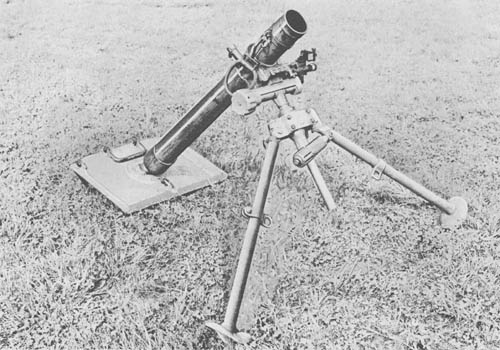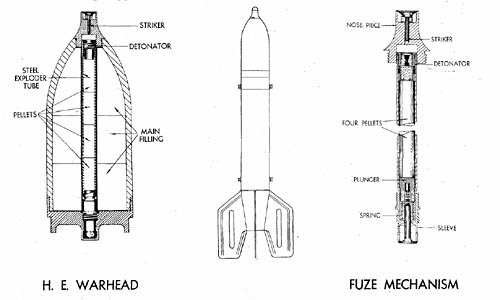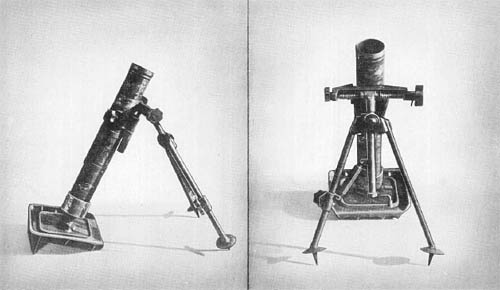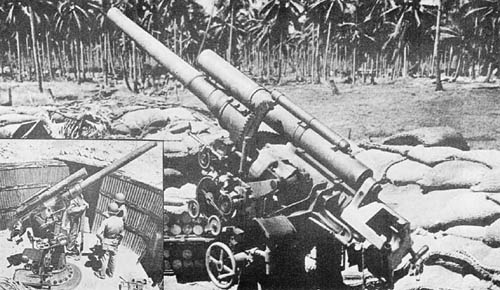
The German 8.1 cm heavy mortar, first manufactured in 1934, is of conventional design, consisting of a tube, base cap, and firing-pin mechanism. Wall thickness of the tube or barrel tapers from 0.288 inch at the base cap to 0.190 inch; a collar at the muzzle slightly increases the wall thickness at that point. A leather-covered handle attached to the collar clamp near the muzzle is used apparently to change elevations when the tube is hot. The firing pin mechanism can be adjusted for two positions. In the “On” position, the pin protrudes into the tube the correct length for firing; in the “Safe” position, the firing-pin head is retracted, permitting greater safety in unloading the mortar in the event of a misfire or other malfunction. The change in setting is readily made by means of an adjuster located on the side of the base ring. The mortar is supported by a bipod and base plate.
The bipod includes cross-leveling, elevating and traversing mechanisms. The legs, and all other nonsliding parts, are made of light white metal. These legs, which have spikes and feet attached to the bottom, are adjusted to any one of six positions by a lever and held in place by locking gears. General construction of the bipod is sturdy and compact. It is easily folded for carrying purposes by swinging the cradle, which is hinged on the traversing mechanism sliding housing, until the left hook at the rear of the cradle is mated in the slot at the top of the rear bipod connector plate. The cradle is then traversed to the left, locking the hooks into the connector plate, and the legs are brought together.
The sighting system, having a total weight of 2 1/2 pounds, includes a collimator, cross level, longitudinal level, and an elevating and lateral deflection mechanism. Machining of the sight parts is excellent, and when in use it is attached to a mount on the left side of the traversing mechanism mount.
SPECIFICATIONS
| Caliber | 81 mm (3.189 ins.) | |
| Weight | ||
| Mortar and Mount | 124 lb. | |
| Mortar | 40 lb. | |
| Mount | 84 lb. | |
| Bipod | 41 1/4 lb. | |
| Base plate | 43 3/4 lb. | |
| Length (overall) | 44 7/8 ins. | |
| Method of loading | Muzzle | |
| Firing mechanism | Firing pin with safety feature | |
| Rate of fire | ||
| Maximum | 45 rds./min. | |
| Practical | 10 to 12 rds./min. | |
| Muzzle velocity | Not determined | |
| Range | ||
| Maximum | 2,625 yds. with light bomb 2,100 yds. with heavy bomb |
|
| Minimum | 66 yds. | |
| Elevation | 40° to 85° | |
| Traverse | 370 mils | |
| Cross leveling, max. correction for cant | 15° | |
| Sights | Collimator type (similar to Brandt sight for 60 mm Mortar, M2) | |
| Lateral adjustment | 6,400 mils | |
| Elevation adjustment | 1,600 mils | |
| Ammunition | ||
| Weight of complete round (smoke shell) | 7.80 lb. | |
| Ignition cartridge charge | 150 grs. | |
| 3 Increment propellents | .35 oz. each |
German: p. 114


